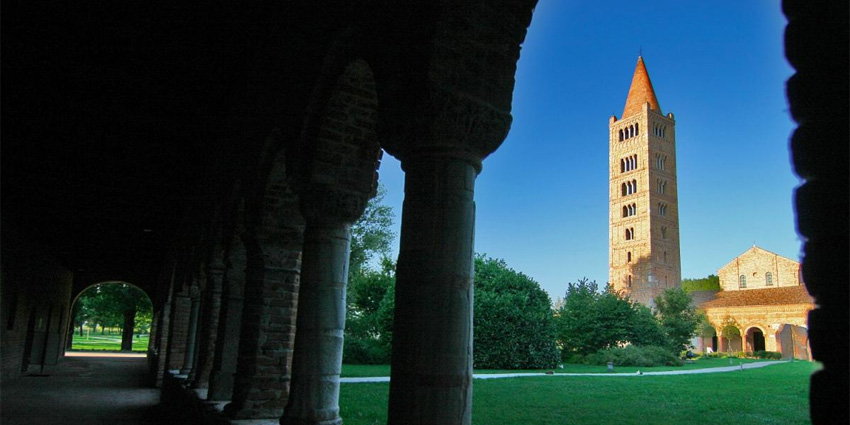
Pomposa Abbey: A Romanesque jewel of history, art, and nature
Pomposa Abbey, located in the municipality of Codigoro in the province of Ferrara, is one of the most important medieval monastic complexes in Italy and Europe.
Positioned strategically between the mainland and the ancient Adriatic Sea, it stands on a strip of land once surrounded by marshes and waters of the Po Delta, a territory that has shaped its history and charm. Its fame is linked not only to its imposing architecture and the works of art it houses, but also to the central role it played as a cultural, religious, and agricultural hub during the Middle Ages.
Origins and development of the monastery
The first evidence of a monastic settlement in Pomposa dates back to between the 6th and 7th centuries, when small groups of monks chose this isolated location to live a life of prayer and work, following the Rule of Saint Benedict. The proximity to the sea and river routes ensured both protection and commercial connections, factors that contributed to the monastery’s prosperity.
The abbey reached its peak between the 11th and 12th centuries, becoming a spiritual and cultural reference point for northern Italy. Thanks to the support of emperors, popes, and nobles, the complex was enriched with buildings and works of art, hosting scholars, scribes, and musicians. Among the most notable figures to reside here was Guido of Arezzo, the Benedictine monk who revolutionised Western music by introducing modern musical notation.
Architecture and symbolism
At the heart of the complex stands the Basilica of Santa Maria, a perfect example of Romanesque architecture in northern Italy. Built in red brick, its façade is simple yet harmonious, decorated with blind arcades and marble inlays. On the side rises the majestic bell tower, 48 metres high, built in 1063, whose two- and three-light windows emphasise the vertical elegance of the structure.
Inside the basilica, the gaze is drawn to 14th-century frescoes, created by masters of the Bolognese and Ferrarese schools, depicting episodes from the Old and New Testaments. The richly decorated polychrome mosaic floor intertwines geometric patterns, animal figures, and Christian symbols, a testament to the artistic sophistication of the time. The crypt, older than the current church, preserves relics and offers an intimate and evocative atmosphere.
The monastery and daily life
In addition to the basilica, the abbey once included the cloister, the convent buildings, the scriptorium, and the chapter rooms. Here, the monks lived according to the Benedictine motto Ora et labora, alternating moments of prayer, study, and agricultural work. The scriptorium was a workshop for manuscript transcription, where religious texts and classical works were copied and illuminated, preserving knowledge in an age when books were rare and valuable.
The monastery managed vast agricultural estates, reclaiming and cultivating the surrounding lands. This economic structure allowed the abbey to maintain a central role in the life of the territory for many centuries.
A place of spirituality and nature
Today, Pomposa Abbey is set within a unique landscape, at the gateway to the Po Delta Park, a protected natural area and UNESCO World Heritage Site. The surrounding environment, with its canals, salt marshes, and lowland forests, creates a profound link between history, spirituality, and nature. The tranquillity enveloping the monastic complex is the same that, for centuries, attracted pilgrims and scholars.
Walking within the abbey walls and observing its architectural and decorative details is like taking a journey back in time, discovering an era in which art, faith, and knowledge were inseparable.
Cultural heritage and territorial identity
Pomposa Abbey is not just a historical monument, but an identity landmark for the entire Ferrara area. Its presence is a testament to the medieval communities’ ability to adapt to a complex environment such as the Po Delta, transforming marshland into a thriving centre of culture and agriculture.
Today, the complex remains open to the public and continues to be a reference point for those wishing to explore Italian medieval history, Romanesque art, and monastic life. Its reputation extends far beyond local borders, attracting visitors from all over the world who seek to experience a heritage that combines artistic beauty, historical value, and spiritual memory.




